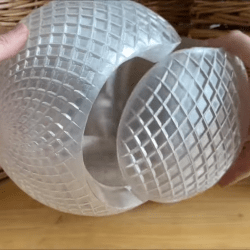[DaveMakesStuff] demonstrates a great technique for 3D printing a sphere; a troublesome shape for filament-based printers to handle. As a bonus, it uses a minimum of filament. His ideas can be applied to your own designs, but his Giant Spiralized Sphere would also just happen to make a fine ornament this holiday season.

The trick is mainly to print the sphere in two parts, but rather than just split the sphere right down the middle, [Dave] makes two hollow C-shaped sections, like a tennis ball. This structure allows the halves to be printed in vase mode, which minimizes filament use while also printing support-free.
Vase (or spiral) mode prints an object using a single, unbroken line of extruded filament. The resulting object has only one wall and zero infill, but it’s still plenty strong for an ornament. Despite its size, [Dave]’s giant ball uses only 220 grams of filament.
A video (also embedded below) shows the design in better detail. If you’d like to experiment, we’ve previously covered how PETG’s transparency is best preserved when 3D printing by using vase mode, slightly overextruding, and printing at a higher temperature to ensure solid bonding between each layer.

















3D print a microwave Luneburg Lens:
* Luneburg Lens – Wikipedia
https://en.wikipedia.org/wiki/Luneburg_lens
as a pedantic commenter, i feel the urge to underline that here we talk about a spherical surface, or a hollow sphere, being a simply defined sphere a solid, i.e. a filled object
I think you’re thinking of a ball – in math parlance, a sphere is a hollow object, analogous to a circle. Both are defined as the set of points with equal distance to some other point, rather than with distance less than or equal to the radius. A ball on the other hand is a solid, analogous to a disk (a filled circle).
Yeah, but the solid isn’t everyone’s default for that word. Sometimes the default is the surface, when a sphere is actually being used as a way to say everything radius r from a point. That’s consistent with things being inside, outside, or on a sphere.
Or, we could go back to the celestial sphere, an imaginary surface of sufficiently large radius that an observation of real celestial objects in a given direction from earth at a particular time may be projected / mapped to a convenient representation. That’s totally the default, and while we’re at it, let’s assume pi is 1. Or 10, whatever.
I think of a sphere as an infinite number of points an equal distance (radius) from the center. And a ball as a filled volume in the shape of a sphere. Most of the time, a sphere is mathematically simpler and more useful to reason with. When you have a filled volume there are lots of weird interactions possible that require some rather complicated equations to describe.
Make a football helmet or they doable.